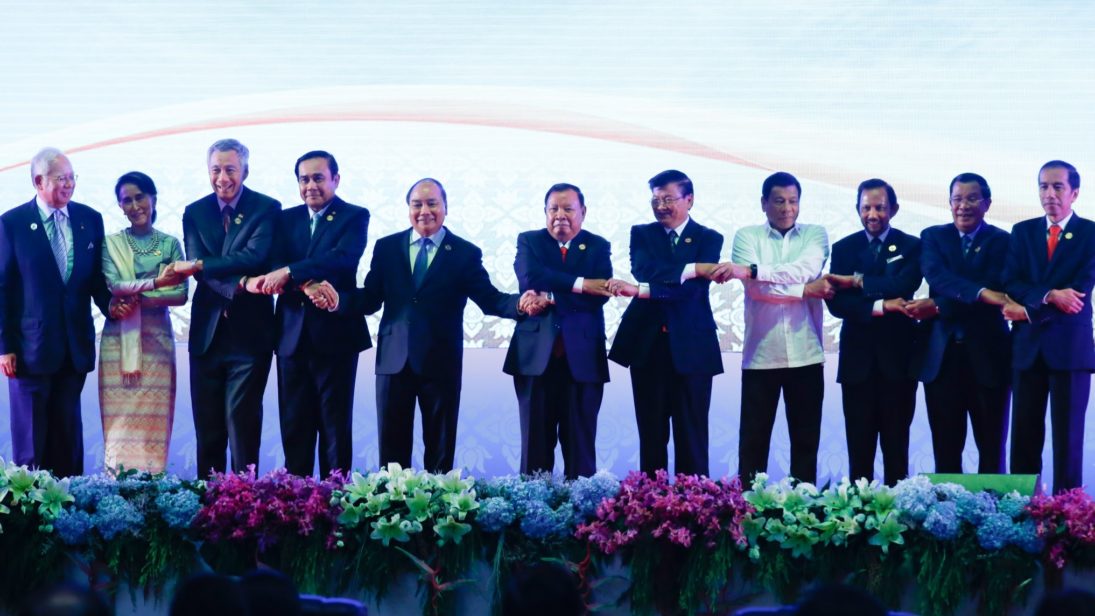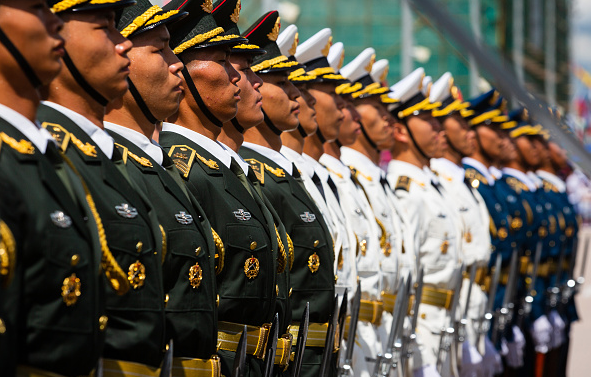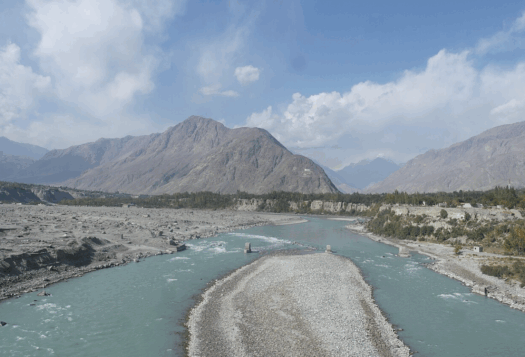
Negating allegations that the grouping takes weak positions on issues of geostrategic sensitivity, the Association of Southeast Asian Nations (ASEAN) recently came out with the “ASEAN Outlook on the Indo-Pacific”, laying out the ten member nations’ position on this important region. The document demonstrates that ASEAN members, centrally located between the waters of the Indian Ocean and the Pacific Ocean, will not give in to binaries and are eager to set their own rules in the game of competing interests and ideologies in the Indo-Pacific.
ASEAN’s Vision for the Indo-Pacific
The document should be seen as ASEAN’s stand against great power rivalry in the Indo-Pacific, seeking to display “collective leadership” in order to be “an honest broker within the strategic environment of competing interests” in the region and emphasizing “dialogue and cooperation.”
The document should be seen as ASEAN’s stand against great power rivalry in the Indo-Pacific, seeking to display “collective leadership” in order to be “an honest broker within the strategic environment of competing interests” in the region and emphasizing “dialogue and cooperation.” It clearly lays down on paper the ASEAN member states’ guiding principles and objectives in the region, which other powers will have to consider while developing their own policies in the Indo-Pacific.
ASEAN envisions the Asia-Pacific and the Indian Ocean regions “not as contiguous territorial spaces but as a closely integrated and interconnected region, with ASEAN playing a central and strategic role.” The document makes crystal clear that ASEAN is not seeking to develop new institutions or replace existing ones but consensually strengthen current mechanisms to deal with regional and global challenges, and bats for the continuation of an ASEAN-centered regional architecture.
It signals that ASEAN seeks a democratic, inclusive, and open Indo-Pacific, which includes both resident powers and those who have a common vision and objectives for the region, and identifies areas of cooperation such as connectivity, economic and maritime cooperation, and the UN’s Sustainable Development Goals 2030. It reiterates ASEAN’s adherence to existing international laws, guidelines, and norms, such as those included within the UN Charter and other relevant treaties, the ASEAN Charter, the UN Convention on the Law of the Sea, and the ASEAN Treaty of Amity and Cooperation, and places importance on peaceful settlement of disputes based upon internationally-accepted rules of law, including a potential role for third-party mediation.
While analyzing the document by itself is instructive, understanding how this ASEAN view compares to other critical players in the region such as China, the United States, and India can offer valuable insights on future dynamics of the region.
Alternate Visions for the Region: China, the United States, and India
China’s New Security Concept
China’s conceptualization of this region, which it refers to as Asia-Pacific, and the architecture it envisions is fundamentally different from ASEAN and others. In fact, it has introduced its own version of security–Beijing strongly advocated moving away from the Western-centric, Cold War mentality of security in its July 2002 position paper on the New Security Concept, calling for the diversification of security to make it inclusive and equitable for all. Beijing claims that this new concept is based on mutual trust, mutual benefit, equality, and coordination, and it seeks settlement of disputes with its neighbors through peaceful negotiation. The paper mentions China’s Gulf of Tonkin/ Beibu Bay settlement with Vietnam as well as negotiations with the ASEAN countries on the issue of the Code of Conduct (COC) on the South China Sea as examples of this.
However, even though China’s “New Security Concept” bills itself as a way to change the existing security structure from being based on a Western, zero-sum game to a more inclusive framework with a win-win mindset based on Asian norms, it is quite different in reality. Despite its claims of equity, China’s approach towards regional architectures in Asia is exclusive, undemocratic, and unequal. For instance, in the leaked COC draft of August 2018, Beijing sought to include a clause that maritime delimitation issues and disputes would be kept out of multilateral negotiations, attempting to instead focus on bilateral discussions and stressing non-involvement of third parties (reference also extends to extra-regional parties such as the United States, which China views as interfering in the negotiations). Beijing has also been seen as repeatedly seeking the upper hand during negotiations with smaller parties. Presenting the Belt and Road Initiative (BRI) as a win-win endeavor but forcing countries into a debt-for-equity swap is a case in point.

Shifting U.S. Perception of Asia
Even though the United States played a large role in ASEAN’s formation and its functioning, over the years there has been a waning trust of Washington and its policies in Southeast Asia. Every U.S. administration places Asia on a different level of priority and develops its regional policies based upon its domestic interests and the geopolitical climate of the time. The Obama administration placed huge importance on Asia through its “pivot” policy, which was infrastructure, development, and trade-oriented. However, the recent Trump administration sees Asia as a military and economic partner against “strategic competitor” China and its policies in the Indo-Pacific have an imprint of that rivalry. In fact, the U.S. shift from a land-oriented Asia-Pacific policy to a maritime-based Indo-Pacific policy is telling of a change in Washington’s changing perception of the region. The renaming of the Pacific Command to the Indo-Pacific Command highlights that the United States sees the waters of the Indian and Pacific Oceans as one zone of influence. And the United States recognizes and upholds the centrality of ASEAN in this region, seeing its geostrategic position in the middle of the two oceans as also its importance as an economic center.
Though the ASEAN Outlook document hasn’t received much attention in the United States, the White House should view it as an encouraging sign for its collaboration with ASEAN. This is because with its focus on a democratic regional security structure as well as support for existing rules and norms, the ASEAN vision for the region hews pretty close to the U.S. view and implicitly rejects the alternate concepts of security raised by China.
India’s Push for an Open and Inclusive Indo-Pacific
There seems to be ideological and normative coherence building within Asian countries on objectives in the Indo-Pacific and the structure of regional security institutions in the region. On these counts, ASEAN’s outlook for the region matches India’s. Although India has not released a formal document on its Indo-Pacific strategy yet, it is clear from several official Indian statements that New Delhi wants a free, open, and inclusive maritime framework in the region. New Delhi has also emphasized the importance of ASEAN centrality in any regional architecture in the Indo-Pacific. Both ASEAN and India place import on existing norms and internationally-accepted rules of law related to freedom of navigation and overflight. Such a convergence provides the foundation for building mutually-acceptable and efficient regional security frameworks where both ASEAN and India can undertake a proactive role.
Conclusion
Several countries including the United States, Japan, and India are working hard to keep institutions in the region democratic and based on equality not unilateralism. “ASEAN’s Outlook on the Indo-Pacific” aligns with this vision.
With the release of this document, a blueprint for ASEAN’s approach to the Indo-Pacific is now known. But what remains to be seen is how ASEAN paves the way for the establishment of an open and inclusive regional architecture while navigating global rivalries.
This document can be a model to follow for other countries that are still formulating their policy for the region and seeking a role in the building of regional security frameworks in the Indo-Pacific, whether as resident nations, major actors, or stakeholders in regional peace and stability. However, even though it is a bold document in letter, its spirit will only be visible if and when the organization devises specific policies to act on these objectives. With the release of this document, a blueprint for ASEAN’s approach to the Indo-Pacific is now known. But what remains to be seen is how ASEAN paves the way for the establishment of an open and inclusive regional architecture while navigating global rivalries.
***
Image 1: Wikimedia
Image 2: Bloomberg via Getty


